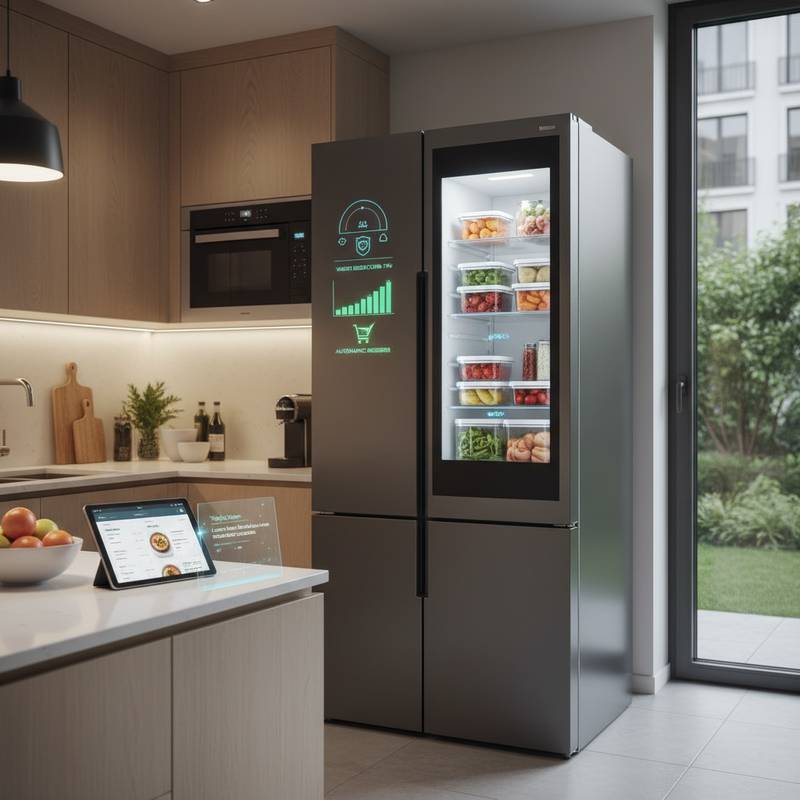Smart Fridges Minimize Waste and Automate Grocery Reorders
Smart homes advance rapidly, and the refrigerator emerges as a key innovator in this shift. No longer just a cooling unit, the contemporary smart fridge functions as an interconnected system that monitors inventory, curbs waste, and initiates automatic reorders when stocks dwindle. Kitchens evolve into predictive spaces where technology streamlines the routine task of food management.
Challenges of Conventional Refrigerators
Many households face significant food waste issues. Overlooked remnants, outdated sauces, and redundant buys occur frequently. Research indicates that a substantial portion of families discard edible food weekly due to poor tracking of fridge contents. This practice wastes funds and burdens the environment through excess manufacturing and landfill contributions. Standard refrigerators respond only after inspection, often revealing spoilage too late.
Innovative Features of Smart Refrigerators
Smart refrigerators address these issues by converting storage into a strategic process. Internal cameras, sensors, and linked applications enable real-time oversight of freshness and stock levels. Integration with delivery platforms allows the device to analyze usage trends and trigger reorders proactively. Households benefit from anticipated needs, fewer excess buys, and reduced spoilage.
Certain models from prominent manufacturers include interactive screens that show use-by dates, propose recipes from current items, and notify about lingering products. Additional units connect with voice-activated systems, permitting queries for stock checks or list additions without accessing the interior.
Advanced Inventory Monitoring
A standout capability involves identifying contents within the unit. Internal imaging paired with recognition algorithms detects everyday goods upon placement or removal. Through a dedicated mobile application, users view inventory remotely during outings, purchasing only necessities.
This transparency prevents multiples of perishables such as dairy or produce, which might otherwise expire unused. It facilitates effective meal preparation by highlighting existing components. Overall, the system promotes utilization of available resources before deadlines, elevating the fridge to an efficient management tool.
Streamlined Automatic Reordering
Automation extends to grocery procurement by adapting to user behaviors. The fridge forecasts requirements for staples and coordinates with partnered services for timely deliveries aligned with schedules.
Consider depleting your fruit supply; the device could arrange replenishment via a selected provider before awareness arises. Customization options permit brand selections or alternatives, maintaining oversight. Such functionality suits demanding families or those seeking simplified routines without forfeiting preferences.
Cutting Waste and Costs Effectively
The primary advantage of smart fridges centers on waste reduction. Precise monitoring of perishables averts overlooked fruits or dated proteins from disposal. Select models issue prompts as dates near, urging prompt consumption. These measures lower expenses and foster eco-friendly habits.
Experts observe rising consumer focus on sustainability, boosting demand for tools blending ease with responsibility. A fridge that optimizes usage translates to decreased spending and a lighter environmental load. This enhancement supports values of productivity and planetary stewardship.
Integration Within Kitchen Networks
Smart fridges operate within broader device arrays for cohesive functionality. For instance, ingredient details can transfer to a compatible cooker, generating meal ideas from stock. Synchronization with personal schedules might suggest rapid preparations on hectic evenings or nutritious selections post-exercise. This connectivity crafts an adaptive kitchen attuned to daily rhythms.
Standardized protocols across brands enhance interoperability, permitting seamless combinations from diverse sources. The outcome yields a harmonious, intelligent space that responds intuitively.
Addressing Privacy and Practicality
Connected appliances prompt concerns over data security and performance. Individuals rightly question handling of habits and purchase records. Established producers mitigate risks via secure transmissions and clear policy controls.
Initial expenses exceed those of basic units. However, growing popularity and normalized features should democratize access over time.
Steps to Integrate a Smart Fridge
Transitioning to a smart fridge marks a move toward intentional habits aided by smart aids. Users gain insights into consumption patterns, refine organization, and select options that balance economy and ecology.
Future advancements promise refined notifications, personalized adjustments, and tighter ties among devices, applications, and suppliers. The evolving fridge will exceed mere preservation, becoming a central ally in household efficiency.
